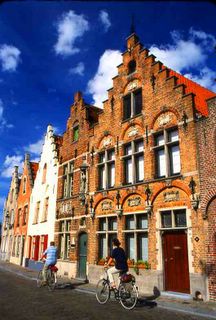
I've always used biking as a cross-training sport, logging the most miles in the saddle during weeks or months of healing from intermittent running injuries. Cycling’s never been a passion, just a means to an end, a way to retain cardiopulmonary and muscle strength during a prolonged running layoff. When you build that stuff up over years, it’s depressing to lose it. I’ve always looked at time on the bike as nothing more than an investment in being able to run well once the pesky bone, joint or muscle of the moment had bounced back.
That view of cycling changed this summer. I’d climbed back on the bike in May, victim of a stress fracture, gloomily pedaling my way through rehab. It’s not that I hated being on the bike. I just didn’t love it. I looked at every road I pedaled down as a road I should have been running on.
Then July brought the Tour de France and Lance Armstrong. I watched every stage and studied the strategy, tactics and nuances of long-distance road cycling. By August, I’d embraced it as a more-than-half-full experience rather than a less-than-half-empty substitute for something else. I bought a new bike (whose gearshift combinations I’m still learning to finesse), brought my mileage up to as much as 50 in a single outing, kicked my top speed from 12 to about 17 miles per hour, learned how to pop wheels off and fix flats, and read every Lance Armstrong-related article or book I could find, including “It’s Not About the Bike: My Journey Back to Life,” which Armstrong wrote with Washington Post sports reporter, Sally Jenkins. I’m going to have my kids read it, not for what it says about sport, but for what it says about hope, our only real antidote to fear, which can paralyze. Hope keeps us moving.
Armed with a new attitude, I’ve been out exploring surrounding towns and cities on two wheels, and I ride almost as many days as I run. It’s wonderful, but biking one’s way through a car-centric society is also dangerous.
I’ve concluded that most drivers resent slowing down, putting cellphone conversations on hold, and giving cyclists a little extra berth. They defiantly resist this anti-American behavior and do what they can to send the message that yes, in fact, they do own the road and they’re not happy about sharing it. (I was careful when choosing my bike. I was more careful choosing my helmet. And I installed a big, oval rearview mirror at the end of my left hand grip and ride in the brightest, wackiest neon colors I can find. I make a beeline for any clothing rack that has screaming yellow or hot pink hanging on it.)
There are places in the world where bicycles get more respect. Like Belgium, which boasts bike paths than run the length and width of the country. When we were in Bruges (Brugge) (above), we explored the medieval canal city's heart on bikes provided free by our hotel, the Adornes, a budget gem with a killer breakfast included in the price. All over the city, people rode bikes, and cars were expected to yield and adapt.
But if you go to Bruges, take a helmet. I saw most people riding without, a decision that no doubt contributes to the city’s cyclist fatality rate. And ride smart. Don’t stop in the middle of a bike path to take a picture, or you might cause a bicycle pile-up.
Which would make you fodder for a post on a blog I found today: Unpopular Blog – The Filipino Twink Blogs Too. In his October 1, 2005 post, “Something Funny Happened On the Way Home,” the blogger, a Filipino expat living in Bruges who bikes to his job at a chocolate factory, used his keyboard to tsk-tsk the “stupid tourists” on bikes who don’t know the rules of the road. Here, the problem is drivers with cellphones and lead feet. There, the problem is cyclists with cameras and hands that can’t lay off the brakes.
Along with whatever skill and wisdom you bring to the rides of your life, a balance of fear and hope seems key to surviving and making it home, no matter what road you’re on.
